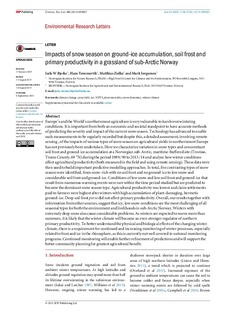Impacts of snow season on ground-ice accumulation, soil frost andprimary productivity in a grassland of sub-Arctic Norway
Peer reviewed, Journal article
Permanent lenke
http://hdl.handle.net/11250/2359582Utgivelsesdato
2015Metadata
Vis full innførselSamlinger
- Publikasjoner fra CRIStin - NINA [2364]
- Scientific publications [1392]
Sammendrag
Europe’s and the World’s northernmost agriculture is very vulnerable to harsh overwintering
conditions. It is important from both an economic and societal standpoint to have accurate methods
of predicting the severity and impact of the current snow season. Technology has advanced to enable
such measurements to be regularly recorded but despite this, a detailed assessment, involving remote
sensing , of the impacts of various types of snow season on agricultural yields in northernmost Europe
has not previously been undertaken. Here we characterize variation in snow types and concomitant
soil frost and ground-ice accumulation at a Norwegian sub-Arctic, maritime-buffered site (Tromsø,
Troms County, 69 °N) during the period 1989/90 to 2013/14 and analyse how winter conditions
affect agricultural productivity (both measured in the field and using remote sensing). These data were
then used to build important predictive modelling approaches. In total, five contrasting types of snow
season were identified, from snow-rich with no soil frost and no ground-ice to low snow and
considerable soil frost and ground-ice. Conditions of low snow and low soil frost and ground-ice that
result from numerous warming events were rare within the time period studied but are predicted to
become the dominant snow season type. Agricultural productivity was lowest and claim settlements
paid to farmers were highest after winters with high accumulation of plant-damaging, hermetic
ground-ice. Deep soil frost per se did not affect primary productivity. Overall, our results together with
information from other sources, suggest that icy, low snow conditions are the most challenging of all
seasonal types for both the environment and livelihoods in sub-Arctic Norway. Winters with
extremely deep snow also cause considerable problems. As winters are expected to warm more than
summers, it is likely that the winter climate will become an even stronger regulator of northern
primary productivity. To better understand the physical and biological effects of the changing winter
climate, there is a requirement for continued and increasing monitoring of winter processes, especially
related to frost and ice in the rhizosphere, as this is currently not well covered in national monitoring
programs. Continued monitoring will enable further refinement of predictions and will support the
better community planning for greatest agricultural benefit.
climate change, crop yield, ice, NDVI, plant mortality, snow dynamics, winter climate

